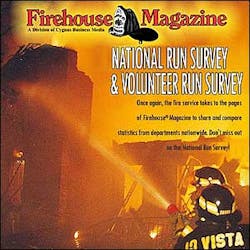National Run Survey: Busiest Departments of 2006 Revealed
For the 26th year, the career fire service takes to the pages of Firehouse Magazine to share and compare statistics about company and department activity levels, funding, staffing and pay. A total of 244 fire departments took part in this year's survey, representing 45 states, the District of Columbia and 8 Canadian provinces.
The departments represented in this latest survey protect 79,994,388 people, and they have budgets totaling more than $12 billion. They provide this service with 4,095 engine companies, 1,489 ladder companies, 1,826 ambulances and numerous other specialized units.
They respond to 1,623,691 fire calls, 7,284,434 EMS calls and 10,757,152 total calls last year.
Here are profiles on the busiest departments in the United States and Canada as listed in the July issue of Firehouse Magazine:
Busiest Department (U.S.)
New York City more than doubled Chicago's call volume for 2006 to become Firehouse Magazine's busiest department in this year's National Run Survey.
With 1,439,616 reported calls, FDNY far surpassed Chicago (664,888) and Houston (590,718), which where ranked second and third on the list respectively.
Since taking over the city's EMS in 1996, the department has stood alone as the only department with over 1 million reported calls in the run survey. With the responsibility of covering EMS, along with fire, hazmat and MVA incidents, it's easy see why the department stays so busy.
"It's the volume of calls we respond to, it's the population of the city -- it's the 8-plus million" who live here, Firefighter Jim Long, a spokesman for FDNY, said. "We respond to calls up and down the ladder."
The department's approximately 11,500 firefighters from more than 240 stations responded to a total of 48,519 fire calls and 1,164,059 EMS calls last year, according to information submitted to Firehouse Magazine.
Long said along with a large call volume, what really challenges FDNY's firefighters are New York's unique features.
"What we have a lot of that other cities don't have are high rise buildings," he said. "Some of them are 50 to 60 stories tall, and those aren't the big ones.
"You're fighting and fire and when you get there you have to climb multiple stories to reach its location. It just adds to the challenge our firefighters face every day."
The city's infrastructure of bridges, tunnels and its subway system routinely also adds to those challenges, Long said.
Along with responding to calls, the FDNY continues to spread the word about fire codes, fire safety, proper maintenance of appliances and utilities and other topics to the city's residents, according to Long.
"The job has gone more toward the prevention side and the importance of educating the public," he said.
Long also said the department is always looking for ways to improve what it does to meet the needs of its community. "We're always adapting and evaluating our services," he said. "We look to keep doing the things we have been doing all of these years as well as do them better."
Busiest Department (Canada)
A sprawling urban city with a population of over 12 million, Toronto holds the title of Canada's busiest fire department.
"We put ourselves in the same category as most major U.S. cities," says Executive Officer Debbie Higgens. "A huge influx of daytime population, a large number of hospitals and large event venues ... that's what separates us from other parts of Canada but make us more like New York or Chicago."
In 2006, the department responded to 139, 368 calls. Higgens said 52 percent (or 73,140) of those were medical calls. Fire calls make up 8,719 and false alarms totaled at 33,655.
Higgens said the department keeps track of incidents and vehicle runs. She said in 2006, the department had 139,368 and in which they sent 294, 660 vehicles.
She said one truck always remains on the scene, even if it's a false alarm.
Toronto boasts the kind of specialized safety that comes with many major American cities.
"We have one of the best developed CBRN (Chemical Biological Radiological and Nuclear) response teams," she said. The department also assists police in their public order unit, and offers all types of rescue training such as swift- and ice-water rescue.
"Not every fire department has all those specialties, but we have it all."
The department also has a fire station especially suited for nearby Toronto Island -- with smaller apparatus to get around narrow roads there.
The Toronto Fire Services were created in 1998, when six former city departments merged into one. Higgens said that fire service officials used that time to make sure the department was working as efficiently as it could.
"We did a station and truck location study," she says. "We made a bunch of changes, moving trucks around to provide better coverage."
Since then, the department recently released a plan of action for the next 10 years. Higgens said they have no drastic changes in mind.
Firefighters in Toronto work 24-hour shifts -- at least for now.
Higgens said city firefighters, who were previously working 10 or 14 hour shifts, pushed hard for the 24-hour shifts. But the department is still in a trial period while they collect information on how the shifts affect the health and well-being of firefighters.
"It was supposed to be a one-year trial period ... but it extended to 2007 and we'll make a decision by the end of the year."
Higgens called Ontario firefighters "a fairly happy bunch."
"We do the best we can for them, even though we have a lot of budget restraints."
One of the more frequent complaints heard from firefighters is the city's fire trucks.
"We have a lot of old fire trucks that we're trying hard to replace but it's a very expensive venture. Some are over 15 years old and not always the most reliable."
